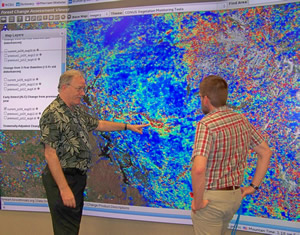by Dawn Levy

An exploratory visualization facility at Oak Ridge National Laboratory has provided researchers with the Forest Service Eastern Forest Environmental Threat Assessment Center and their partners a unique view of maps used for detecting and tracking unexpected forest change and disturbances.
The researchers are part of a large team that developed the first near-real-time forest threat early warning system in the contiguous United States. Called ForWarn, the satellite-based system delivers maps that provide information about forest greenness from coast to coast every eight days. The maps compare current vegetation greenness levels to those from a year ago, three years ago, and the past decade to highlight potential disturbances and post-disturbance recovery. ForWarn provides tools to help attribute disturbances to insects, disease, wildfire, extreme weather, and human development.
On Aug. 23 research ecologists Bill Hargrove and Steve Norman, both of the Forest Service, came to ORNL to meet with Forrest Hoffman and Jitendra Kumar, experts in data analytics algorithms at ORNL’s Climate Change Science Institute. To turn data into insight, they viewed recent ForWarn maps at an immersive facility called EVEREST, which stands for Exploratory Visualization Environment for Research in Science and Technology. The facility creates depth in detailed images for a 3D effect using 18 individual display monitors, each of which has 1920-by-1080-pixel resolution. The monitors are arranged in a 6-by-3 configuration to create a 37-megapixel wall, which the Oak Ridge Leadership Computing Facility at ORNL operates.
When the Forest Service researchers came to ORNL to analyze “big data” regarding a number of forest disturbances, they were at the right place at the right time to view effects of past wildfires in the West and give the massive Rim Fire burning in California near Yosemite National Park a closer look. The ForWarn “Early Detect” map showing the Yosemite wildfire had just been processed and made available that day.
ForWarn researchers say that the tool’s capability to provide information about the fitness of forests over time may improve predictions about the number of years required for vegetation to recover to its prefire level of greenness. Through close examination of vegetation impacts, the collaborators may be able to help resource managers track recovery from increasingly frequent and intense blazes, including the Rim Fire—now California’s third-largest wildfire.—by Stephanie Worley Firley, US Department of Agriculture’s Forest Service, and Dawn Levy, Department of Energy’s Oak Ridge National Laboratory
